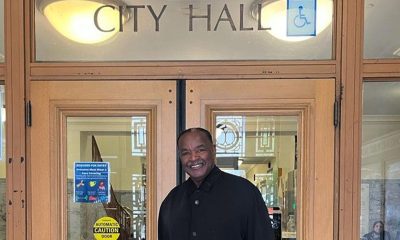Politics
Whites Moving to Detroit, City That Epitomized White Flight

In this April 24, 2015 photo, Eugene Gualtieri, a 41-year-old lab technician at the Detroit Medical Center, prepares to ride his motorcycle in Detroit. Gualtieri took advantage of an incentive program, Live Midtown, offered by his employer and several others in the Midtown neighborhood, which allowed him to take out a $20,000 home loan that he wont have to repay if he stays in his condo for five years. In Detroit its cheap housing and incentive programs that are partly fueling the regrowth of the Motor Citys white population. (AP Photo/Carlos Osorio)
COREY WILLIAMS, Associated Press
DETROIT (AP) — Whites are moving back to the American city that came to epitomize white flight, even as blacks continue to leave for the suburbs and the city’s overall population shrinks.
Detroit is the latest major city to see an influx of whites who may not find the suburbs as alluring as their parents and grandparents did in the last half of the 20th century. Unlike New York, San Francisco and many other cities that have seen the demographic shift, though, it is cheap housing and incentive programs that are partly fueling the regrowth of the Motor City’s white population.
“For any individual who wants to build a company or contribute to the city, Detroit is the perfect place to be,” said Bruce Katz, co-director of the Global Cities Initiative at the Washington-based Brookings Institution. “You can come to Detroit and you can really make a difference.”
No other city may be as synonymous as Detroit with white flight, the exodus of whites from large cities that began in the middle of the last century. Detroit went from a thriving hub of industry with a population of 1.8 million in 1950 to a city of roughly 690,000 in 2013 that recently went through the largest municipal bankruptcy in U.S. history. In that time, the city’s population went from nearly 84 percent white to a little less than 13 percent white.
In the three years after the 2010 U.S. Census, though, Detroit’s white population grew from just under 76,000 residents to more than 88,000, according to a census estimate. The latest annual census was released Thursday and estimates that Detroit lost about 10,000 more residents in 2014, but it doesn’t include a racial breakdown.
Simple math convinced music producer Mike Seger to move from adjacent Oakland County into a rented two-story house on Detroit’s east side that also houses his Get Fresh Studio. Seger, 27, pays $750 per month in rent, and said he wouldn’t have been able to find anything comparable in the suburbs for that price. The average monthly rental rate of a three-bedroom single-family home in Detroit is about $800, as opposed to $1,100 to $1,400 in the suburbs, according to RentRange.com, which collects rental market information.
“A young person can move here with $10,000 and start up a small flex space for artists or artists’ studios,” Seger said. “It’s the uprising of the youth being able to have the opportunities to make a future for themselves.”
Eugene Gualtieri, a 41-year-old lab technician at the Detroit Medical Center, took advantage of an incentive program. Live Midtown, offered by his employer and several others in the Midtown neighborhood, allowed him to take out a $20,000 home loan that he won’t have to repay if he stays in his condo for five years. The program is aimed at getting workers to live closer to their jobs, which can benefit employers and employees.
“The condo is eight minutes from work … super close, nice neighborhood and really reasonably priced,” Gualtieri said. “Like any part of any city, I’m sure there are good parts and bad parts. You just make sure you don’t end up in the areas you are not supposed to be in.”
Live Downtown is a similar incentive program offered by employers located in downtown Detroit, which is home to General Motors, Quicken Loans and Blue Cross Blue Shield of Michigan. Three professional sports teams and stadiums, three casinos, restaurants and bars are entertainment anchors.
Blacks appear to be weary of waiting for Detroit to turn things around and have been migrating to nearby suburbs in search of comfort, better schools and lower crime.
The city’s black population was nearly 776,000 in 1990. By 2013 it had dipped to an estimated 554,000.
Elizabeth St. Clair, 27, and her family may count themselves among black former Detroiters.
St. Clair and her boyfriend are searching for rental homes in Detroit and several inner-ring suburbs. She has two school-aged children.
She acknowledges things are getting better — pointing out Detroit’s current campaign to tear down vacant houses and eradicate blight. But the high cost of car insurance, underperforming schools and the condition of many neighborhoods are obstacles.
“As I see a resurgence of Detroit, I really want to stay here,” St. Clair said. “I feel there are two Detroits. There’s a Detroit where you are able to go downtown and enjoy, and then in our neighborhoods there’s not much change.”
Susan Mosey, who heads the nonprofit planning and development group Midtown Detroit Inc., said about 1,150 people have participated in the Live Midtown program, 38 percent of whom are white and 38 percent of whom are black. She said it’s great to see whites moving back to Detroit, but the city needs to attract more people and stop others from leaving.
“The reality is this town is not diverse enough,” Mosey said of Detroit as a whole. “We need new immigrants and more whites to move in. We lost so many of the middle-class African-Americans during the recession. We need good numbers of all people to come back.”
Copyright 2015 The Associated Press. All rights reserved. This material may not be published, broadcast, rewritten or redistributed.
Activism
Oakland Post: Week of April 24 – 30, 2024
The printed Weekly Edition of the Oakland Post: Week of April 24 – 30, 2024

To enlarge your view of this issue, use the slider, magnifying glass icon or full page icon in the lower right corner of the browser window. ![]()
Bay Area
MAYOR BREED ANNOUNCES $53 MILLION FEDERAL GRANT FOR SAN FRANCISCO’S HOMELESS PROGRAMS
San Francisco, CA – Mayor London N. Breed today announced that the U.S. Department of Housing and Urban Development (HUD) has awarded the city a $53.7 million grant to support efforts to renew and expand critical services and housing for people experiencing homelessness in San Francisco.

FOR IMMEDIATE RELEASE:
Wednesday, January 31, 2024
Contact: Mayor’s Office of Communications, mayorspressoffice@sfgov.org
***PRESS RELEASE***
MAYOR BREED ANNOUNCES $53 MILLION FEDERAL GRANT FOR SAN FRANCISCO’S HOMELESS PROGRAMS
HUD’s Continuum of Care grant will support the City’s range of critical services and programs, including permanent supportive housing, rapid re-housing, and improved access to housing for survivors of domestic violence
San Francisco, CA – Mayor London N. Breed today announced that the U.S. Department of Housing and Urban Development (HUD) has awarded the city a $53.7 million grant to support efforts to renew and expand critical services and housing for people experiencing homelessness in San Francisco.
HUD’s Continuum of Care (CoC) program is designed to support local programs with the goal of ending homelessness for individuals, families, and Transitional Age Youth.
This funding supports the city’s ongoing efforts that have helped more than 15,000 people exit homelessness since 2018 through City programs including direct housing placements and relocation assistance. During that time San Francisco has also increased housing slots by 50%. San Francisco has the most permanent supportive housing of any county in the Bay Area, and the second most slots per capita than any city in the country.
“In San Francisco, we have worked aggressively to increase housing, shelter, and services for people experiencing homelessness, and we are building on these efforts every day,” said Mayor London Breed. “Every day our encampment outreach workers are going out to bring people indoors and our City workers are connecting people to housing and shelter. This support from the federal government is critical and will allow us to serve people in need and address encampments in our neighborhoods.”
The funding towards supporting the renewal projects in San Francisco include financial support for a mix of permanent supportive housing, rapid re-housing, and transitional housing projects. In addition, the CoC award will support Coordinated Entry projects to centralize the City’s various efforts to address homelessness. This includes $2.1 million in funding for the Coordinated Entry system to improve access to housing for youth and survivors of domestic violence.
“This is a good day for San Francisco,” said Shireen McSpadden, executive director of the Department of Homelessness and Supportive Housing. “HUD’s Continuum of Care funding provides vital resources to a diversity of programs and projects that have helped people to stabilize in our community. This funding is a testament to our work and the work of our nonprofit partners.”
The 2024 Continuum of Care Renewal Awards Include:
- $42.2 million for 29 renewal PSH projects that serve chronically homeless, veterans, and youth
- $318,000 for one new PSH project, which will provide 98 affordable homes for low-income seniors in the Richmond District
- $445,00 for one Transitional Housing (TH) project serving youth
- $6.4 million dedicated to four Rapid Rehousing (RRH) projects that serve families, youth, and survivors of domestic violence
- $750,00 for two Homeless Management Information System (HMIS) projects
- $2.1 million for three Coordinated Entry projects that serve families, youth, chronically homeless, and survivors of domestic violence
In addition, the 2023 CoC Planning Grant, now increased to $1,500,000 from $1,250,000, was also approved. Planning grants are submitted non-competitively and may be used to carry out the duties of operating a CoC, such as system evaluation and planning, monitoring, project and system performance improvement, providing trainings, partner collaborations, and conducting the PIT Count.
“We are very appreciative of HUD’s support in fulfilling our funding request for these critically important projects for San Francisco that help so many people trying to exit homelessness,” said Del Seymour, co-chair of the Local Homeless Coordinating Board. “This funding will make a real difference to people seeking services and support in their journey out of homelessness.”
In comparison to last year’s competition, this represents a $770,000 increase in funding, due to a new PSH project that was funded, an increase in some unit type Fair Market Rents (FMRs) and the larger CoC Planning Grant. In a year where more projects had to compete nationally against other communities, this represents a significant increase.
Nationally, HUD awarded nearly $3.16 billion for over 7,000 local homeless housing and service programs including new projects and renewals across the United States.
Activism
Oakland Post: Week of April 17 – 23, 2024
The printed Weekly Edition of the Oakland Post: Week of April 17 – 23, 2024

To enlarge your view of this issue, use the slider, magnifying glass icon or full page icon in the lower right corner of the browser window. ![]()
-

 Community2 weeks ago
Community2 weeks agoFinancial Assistance Bill for Descendants of Enslaved Persons to Help Them Purchase, Own, or Maintain a Home
-

 Activism4 weeks ago
Activism4 weeks agoOakland Post: Week of April 3 – 6, 2024
-

 Business2 weeks ago
Business2 weeks agoV.P. Kamala Harris: Americans With Criminal Records Will Soon Be Eligible for SBA Loans
-

 Community2 weeks ago
Community2 weeks agoAG Bonta Says Oakland School Leaders Should Comply with State Laws to Avoid ‘Disparate Harm’ When Closing or Merging Schools
-

 Activism3 weeks ago
Activism3 weeks agoOakland Post: Week of April 10 – 16, 2024
-

 Community2 weeks ago
Community2 weeks agoOakland WNBA Player to be Inducted Into Hall of Fame
-

 Community2 weeks ago
Community2 weeks agoRichmond Nonprofit Helps Ex-Felons Get Back on Their Feet
-

 Community2 weeks ago
Community2 weeks agoRPAL to Rename Technology Center for Retired Police Captain Arthur Lee Johnson






















































